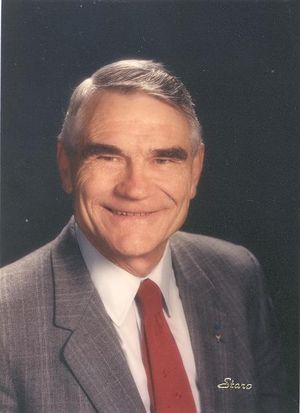Eugene C. Sakshaug: Difference between revisions
(Created page with "== Biography == Eugene C. Sakshaug was born on October 18, 1923 in Mandan, North Dakota. He attended North Dakota State University for one year before enlisting in the Marine C...") |
m (Text replace - "[[Category:Power, energy & industry application|" to "[[Category:Power, energy & industry applications|") |
||
| (4 intermediate revisions by 2 users not shown) | |||
| Line 1: | Line 1: | ||
== Biography == | == Biography == | ||
Eugene C. Sakshaug was born on October 18, 1923 in Mandan, North Dakota. | [[Image:Eugene C. Sakshaug 2689.jpg|right|thumb]] | ||
Eugene C. Sakshaug was born on October 18, 1923 in Mandan, North Dakota. He attended North Dakota State University for one year before enlisting in the Marine Corps during World War II, after which he enrolled in North Carolina State University. He received his BEE degree in 1952, and immediately entered the employ of the [[General Electric (GE)|General Electric Company]]. He was involved in the design and application of power surge protection devices during most of his 32 years with GE, directing research on the development of current limiting gap arresters in the early 1960’s and contributing to improvements and modifications to arresters for 500 kV and 800 kV systems. In the late 1960’s he and his colleagues developed arresters for the first high voltage DC system constructed in the United States. In the 1970’s, Mr. Sakshaug directed his attention to the development of zinc oxide semiconductor materials for use in surge arresters. | |||
Mr. Sakshaug authored many IEEE papers relating to the design of arresters; two of these papers received the Power Engineering Society Surge Protection Devices Committee Prize Paper Award in 1979 and 1982. In 1978, he received the 1978 WRG Baker prize awarded by the Power Engineering Society for one of his IEEE papers. Mr. Sakshaug retired from GE in 1984, but continued his involvement in arresters as an industry consultant into the 1990’s . | |||
By the end of his career, Mr Sakshaug was widely acknowledged as the “king of arrester design” in the United States, | By the end of his career, Mr Sakshaug was widely acknowledged as the “king of arrester design” in the United States, and dominated this sector of the industry like no one since Edison. He is a member of Tau Beta Pi, Eta Kappa Nu, Phi Kappa Phi, and Sigma Zi, as well as the IEEE and the National Academy of Engineering. In recognition to his considerable contributions to the field of electrical engineering, in 1989 Mr. Sakshaug was awarded the [[IEEE Lamme Medal|IEEE’s Lamme Gold Medal]]. | ||
[[Category:Components, | [[Category:Components, circuits, devices & systems|Sakshaug]] [[Category:Electronic components|Sakshaug]] [[Category:IEEE|Sakshaug]] [[Category:Awards & fellow activities|Sakshaug]] [[Category:Power, energy & industry applications|Sakshaug]] [[Category:Power electronics|Sakshaug]] | ||
[[Category: | |||
[[Category:IEEE]] | |||
[[Category: | |||
[[Category:Power, | |||
[[Category: | |||
Revision as of 13:49, 13 November 2013
Biography
Eugene C. Sakshaug was born on October 18, 1923 in Mandan, North Dakota. He attended North Dakota State University for one year before enlisting in the Marine Corps during World War II, after which he enrolled in North Carolina State University. He received his BEE degree in 1952, and immediately entered the employ of the General Electric Company. He was involved in the design and application of power surge protection devices during most of his 32 years with GE, directing research on the development of current limiting gap arresters in the early 1960’s and contributing to improvements and modifications to arresters for 500 kV and 800 kV systems. In the late 1960’s he and his colleagues developed arresters for the first high voltage DC system constructed in the United States. In the 1970’s, Mr. Sakshaug directed his attention to the development of zinc oxide semiconductor materials for use in surge arresters.
Mr. Sakshaug authored many IEEE papers relating to the design of arresters; two of these papers received the Power Engineering Society Surge Protection Devices Committee Prize Paper Award in 1979 and 1982. In 1978, he received the 1978 WRG Baker prize awarded by the Power Engineering Society for one of his IEEE papers. Mr. Sakshaug retired from GE in 1984, but continued his involvement in arresters as an industry consultant into the 1990’s .
By the end of his career, Mr Sakshaug was widely acknowledged as the “king of arrester design” in the United States, and dominated this sector of the industry like no one since Edison. He is a member of Tau Beta Pi, Eta Kappa Nu, Phi Kappa Phi, and Sigma Zi, as well as the IEEE and the National Academy of Engineering. In recognition to his considerable contributions to the field of electrical engineering, in 1989 Mr. Sakshaug was awarded the IEEE’s Lamme Gold Medal.
